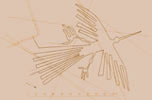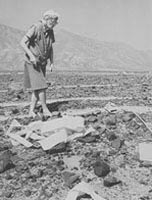In the middle of the night – long before sunrise, Maria’s working day was starting.
She hitched every morning on the loading space of several lorries from the town Nazca
to the desert. Already in the first days of June 1946 she found a stylized drawing
of a spider between the lines. The spider was very hard to see, because during the
centuries the wind has blew a thin layer of little stones over it. Little by little
she discovered more and more of the geoglyphs, but at the beginning it was not her
main task.
With measuring tape, sextant and compass, later also with a theodolite she
measured almost 1000 lines and investigated them for their astronomical orientation.
Maria walked long distances without some food often loaded with measuring devices and
ladder.
To save the time-consuming journey from Nazca to the desert she moved in a simple
hut without water and electricity at the edge of the desert.
Later as her eyesight became worse she turned her attention to the geoglyphs.
She was asking herself how this huge drawings could made in this technical and artistic
perfection and suspected a system of units, which could used to draw the geoglyphs
at the soil of the desert.
She investigated the Nazca drawings for more than 40 years and received an
extensive help from the office for aerial photographs of the Peruvian air force (SAN).
They enabled her a number of flights over the drawings, where she made valuable aerial
photos.
|


